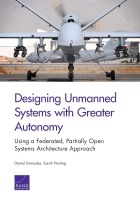Abstract
Current unmanned systems (UxSs) use different communication systems and have limited autonomy, which can contribute to interoperability problems and limit the degree to which information collected by these systems can be shared with warfighters and other UxSs operating in the same area. UxSs may also face survivability and mission effectiveness challenges when they operate in contested environments or against adversaries with significant electronic or cyber warfare capabilities. Improving UxS autonomy can address these challenges. This report identifies a partially open systems architecture (POSA) approach that can improve system interoperability and autonomy. A POSA reference model is proposed for unmanned aircraft vehicles that can enable new autonomous capability modules to be inserted into the system.
 |
| JHU/APL Single Vehicle Architecture |
 |
| MIT/LL Reference Architecture |
Key Findings
Open System Architecture Principles Can Help Meet Objectives
Each UxS program has developed its own custom architectures, so any effort to develop a joint common architecture using traditional approaches would be additive and costly to existing efforts.
To use architectures efficiently in the UxS design process, they should be shared electronically, and although architecture data are electronic, the programs often use different and non-interoperable applications. These electronic information-sharing limitations were key
shortcomings of version 1.0 of the Department of Defense Architecture Framework.
A common UxS architecture would be too difficult to create in the
near term because of the significant differences in the functionality
and design of unmanned aircraft systems (UASs), unmanned ground systems, and unmanned maritime systems.
Recommendations
Incrementally develop a common UAS architecture syntax.
Adopt the proposed UAS technical reference model, which is based on a partially open system architecture approach to ease integration of autonomous capabilities into UASs.
Conduct further research on the software designs of these systems before a decision is made on whether their architectures should be federated or before technical reference models are developed for them.
 Designing Unmanned Systems with Greater Autonomy: Using a Federated, Partially Open Systems Architecture Approach | RAND
Designing Unmanned Systems with Greater Autonomy: Using a Federated, Partially Open Systems Architecture Approach | RAND

No comments:
Post a Comment